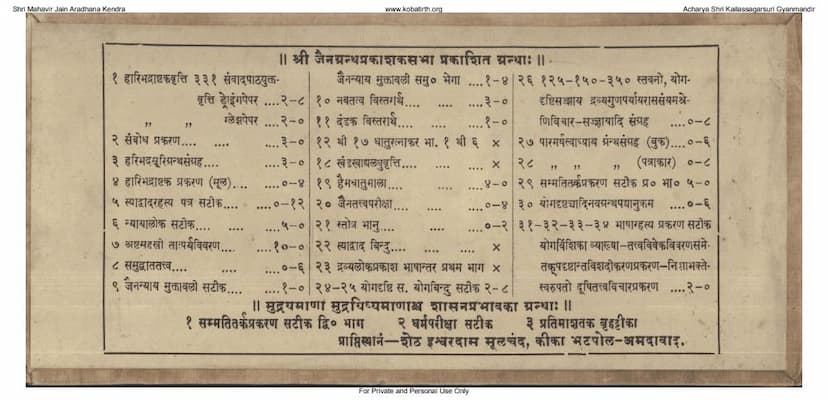Rohiney Charitram
Added to library: September 2, 2025

Summary
Here's a comprehensive summary of the Jain text "Rohiney Charitram" by Devmurti Upadhyay, based on the provided text:
Title: Rohiney Charitram (The Story of Rohiney) Author: Devmurti Upadhyay Publisher: Shravak Hiralal Hansraj Theme: The narrative chronicles the life and spiritual transformation of Rohiney, a character with a criminal past who ultimately embraces Jainism and achieves liberation.
Key Narrative Points:
The story begins by establishing the setting in the Magadha region, near Rajagriha city and the Vainar mountain. This mountain is described as a place inhabited by both thieves and ascetics, and is filled with various flora and fauna.
-
The Thief Family: The prominent figure in the story is a master thief named Rupyakhur (Silver-hoofed), known for his courage and wealth. He resides on the Vainar mountain with his group of thieves. Rupyakhur's son is Rohiney.
-
Rohiney's Prowess and Dilemma: Rohiney, from birth, shows exceptional intelligence and a remarkable aptitude for various skills, including understanding languages, mimicking sounds, and even transforming himself into animals. Despite his natural talents, he is raised in a family of thieves and witnesses his father's activities. However, he begins to question the morality of thievery. He expresses to his father that he cannot engage in thievery, drinking, or violence, as these actions are contrary to his inherent nature and the teachings he has absorbed. He questions the legitimacy of stealing when his father lives a life of ease.
-
The Sage's Prophecy: A sage (Samvatsar) predicts that Rohiney will become a great and virtuous person, known throughout the three worlds as "Rohiney." This prophecy deeply impacts Rupyakhur, filling him with both joy and sadness.
-
Encounter with Shrenik: King Shrenik of Rajagriha is also mentioned. Upon hearing about Rohiney, he expresses his admiration and surprise. Rohiney, at the age of eight, is already exceptionally skilled and knowledgeable, baffling even learned individuals. He displays an uncanny ability to understand and influence others' thoughts.
-
Rohiney's Moral Conflict and Choice: Rohiney's father, Rupyakhur, tries to instill in him the family's criminal traditions, but Rohiney firmly rejects them, highlighting the detrimental effects of gambling, drinking, and stealing. He questions how he can eat the flesh of animals if he wishes to live a righteous life and criticizes his father's materialistic pursuits. He states that he will not follow the path of his ancestors and expresses his disdain for their criminal lifestyle.
-
The King's Judgment and Rohiney's Actions: The narrative then shifts to Rohiney's more active exploits. He exhibits extraordinary abilities, transforming into different forms and even manipulating people through his powers. He demonstrates his skills by causing chaos and confusion among the king's guards and officials. He cleverly steals from the king, including a precious jewel, and even manipulates the royal treasurer.
-
The Minister's Investigation and Rohiney's Virtues: The King's minister, Anay, investigates these incidents. Rohiney, meanwhile, abandons his thieving ways and starts a legitimate business in Rajagriha. He engages in trade, helps the poor and needy, and earns a reputation for his generosity and righteousness. He is recognized as a virtuous and compassionate individual.
-
The Minister's Test and Rohiney's Faith: The minister, Anay, becomes suspicious of Rohiney and attempts to test him. He orchestrates events that seem to implicate Rohiney. However, Rohiney consistently demonstrates his adherence to Jain principles. He refuses to participate in unrighteous activities and maintains his devotion to Lord Mahavir.
-
The Divine Intervention and Spiritual Realization: In a significant turn of events, Rohiney is taken to a fabricated heavenly realm and offered pleasures. However, he recognizes that this is an illusion created by the minister's magic. He rejects the false pleasures and reaffirms his devotion to Lord Mahavir and the Jain path. He realizes that true happiness lies in spiritual pursuits and righteous conduct.
-
Confrontation and Transformation: Rohiney confronts the minister, revealing his understanding of the illusion. He declares his commitment to Jainism and his rejection of his past life. The minister, impressed by Rohiney's unwavering faith and wisdom, acknowledges his mistakes and seeks forgiveness.
-
The King's Recognition and Rohiney's Enlightenment: King Shrenik, upon learning the truth from the minister, recognizes Rohiney's true nature and virtue. Rohiney, having undergone a profound spiritual transformation, takes initiation into Jainism.
-
Liberation: The story concludes with Rohiney practicing severe penance and ultimately achieving liberation (Moksha). The narrative emphasizes the power of right faith (Samyak Darshan), knowledge, and conduct in overcoming a criminal past and attaining spiritual freedom.
Overall Message:
"Rohiney Charitram" is a powerful narrative illustrating the Jain principle of transformation. It highlights that even individuals with a criminal background can achieve spiritual enlightenment and liberation through sincere effort, devotion, and adherence to Jain teachings. The story emphasizes the importance of:
- Right Faith (Samyak Darshan): Recognizing the truth of Jain philosophy.
- Right Knowledge (Samyak Gyan): Understanding Jain principles and their implications.
- Right Conduct (Samyak Charitra): Living a life of non-violence, truthfulness, and ethical behavior.
The text serves as an inspirational tale, demonstrating that the path to spiritual liberation is open to all, regardless of their past actions, as long as they embrace the true teachings and strive for spiritual purification.